We explore the history of Pi, examine rheumatoid arthritis and seek the science of sleep in this roundup of the British Science Festival. In the news, we hear how to read the history of the solar system on the surface of the moon, and discover a development in quantum computing. Plus, we launch Naked Engineering, stripping off the image of dirty overalls to discover how engineers solve real-world problems. Diana asks if olive oil is healthier than butter in our Question of the Week.
In this episode
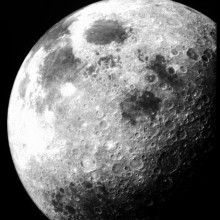
01:42 - Heavy Moon Bombardment
Heavy Moon Bombardment
One of the most obvious things about the Moon is that it is covered with impact craters, but these are not uniform. Some older areas called the highlands are very heavily cratered where as the 'mares', thought to be seas by early astronomers, have much fewer craters. This is because the mares have been resurfaced with molten rock more recently showing that the number of impacts has reduced over time.
One theory about these craters says that there was an event called the Late Heavy Bombardment about 3.8 billion years ago which was both far more intense and different from the impacts that have occurred since.
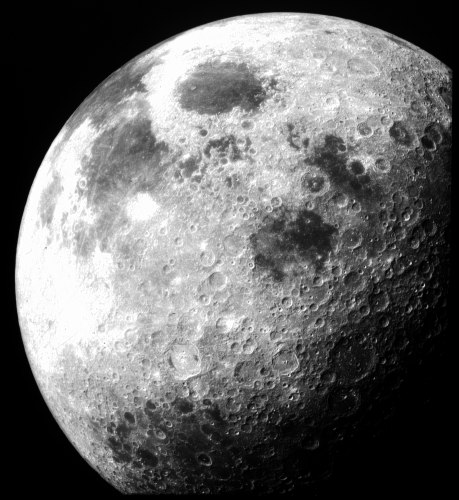 As going to and dating each individual crater is ridiculously expensive, you have to study thousands of craters from orbit and use statistics to date them. Normally this is done from photographs, which is a problem, as different lighting, can change which craters are visible, causing problems for your statistics. Howver the Lunar reconnaissance orbiter which was launched last year includes a laser altimeter which has built up a 3d map of the moon avoiding these complicating factors.
As going to and dating each individual crater is ridiculously expensive, you have to study thousands of craters from orbit and use statistics to date them. Normally this is done from photographs, which is a problem, as different lighting, can change which craters are visible, causing problems for your statistics. Howver the Lunar reconnaissance orbiter which was launched last year includes a laser altimeter which has built up a 3d map of the moon avoiding these complicating factors.
James Head and collegues have been studying craters larger than 20km across using this map. One result was that the lunar highlands the craters cover 3-10% of the landscape, which is effectively the highest you can ever find, as new craters erase the older ones, so there is unlikely to be any original lunar surface left.
They have also been comparing different aged surfaces. The younger ones have the distribution of crater sizes you would expect from the asteroids which are presently crossing the earth's orbit. However the older highlands dating from before the Late Heavy Bombardment seem to include far more large craters then they should, and in fact look very like the distribution of asteroids you find in the main belt of asteroids.
This indicates that the Late Heavy Bombardment wasn't just a more intense version of the bombardment that has occurred ever since, but something different. One theory is that the orbits of Jupiter and Saturn changed during the early solar system setting up resonances in the main asteroid belt destabilising it, and hurling a random selection of its contents into the inner solar system, which would of course have had an even more catastrophic effect on the larger and heavier Earth possibly having huge effects on Earth life developing at this time.

05:17 - Night-light's affecting bird breeding
Night-light's affecting bird breeding
Worsening light pollution is significantly affecting bird's breeding habits, a new study has revealed.
Bart Kempenaers and his colleagues at the Max Planck Institute for Ornithology in Seewiesen, Germany, writing in Current Biology, carried out a 7 year study comparing the behaviours of five different songbird species (robins, blackbirds, great tits, blue tits and chaffinches) inhabiting either dark, central woodland territories, or light-contaminated "edge" territories.
Male birds living in the light-polluted areas, they found, were starting to sing significantly sooner - in some cases up to two hours earlier in the morning - than their darker-living counterparts. The effect was also more marked amongst the species that naturally tended to wake up earlier anyway, such as robins and blackbirds. Females exposed to light-pollution were also laying eggs an average of 1.5 days earlier.
The team also found that males living in lighter "edge" territories were twice as likely to father "extra-pair" offspring (the avian equivalent of love children), probably because they won more female attention by starting to sing sooner than darker-living rivals. However, since females usually select as extra-pair mate choices males they perceive to be highly reproductively "fit", basing their selection on dawn song as a measure of healthy male virility, the early male risers may be thwarting the selection system and fooling females into breeding with the wrong guys with obvious negative consequences for the species.

08:19 - Mechanism of Prozac mood-boost unlocked
Mechanism of Prozac mood-boost unlocked
In a move that could hold the key to better drugs to beat a range of mood disorders including depression, French scientists have solved a vital piece of the puzzle of how certain antidepressants work.
For over 50 years it's been known that too little of the nerve transmitter serotonin in the brain is linked to low mood, while drugs like Prozac that raise the levels of the agent have a mood-boosting effect. But it's remained a mystery why, despite measurable responses to the drug occurring almost immediately after it's given, depression sufferers still need to take the drug for more than three weeks before they begin to feel better.
 Now, writing in Science, Paris-Descartes University scientist Anne Baudry and her colleagues have discovered the delay is down to the time the brain takes to turn one type of nerve cell into another, which in turn leads to symptomatic improvements. Using both cultured cells and experimental mice, the team found that administering Prozac (fluoxetine) turns on the production in the cell of a small molecule known as micro RNA 16 (miR-16) which, in turn, stops cells from producing uptake pumps that deactivate serotonin.
Now, writing in Science, Paris-Descartes University scientist Anne Baudry and her colleagues have discovered the delay is down to the time the brain takes to turn one type of nerve cell into another, which in turn leads to symptomatic improvements. Using both cultured cells and experimental mice, the team found that administering Prozac (fluoxetine) turns on the production in the cell of a small molecule known as micro RNA 16 (miR-16) which, in turn, stops cells from producing uptake pumps that deactivate serotonin.
However, unexpectedly, they also found that the Prozac molecule triggers a different family of neurones, which normally use the nerve transmitter chemical noradrenaline, to turn off their production of miR-16. This causes the cells to turn on genes that pick up and recycle "spare" serotonin in the brain, turning the noradrenaline-using cells into serotonin-utilising cells. And because the team have discovered the factor that triggers this chemical identity switch, it may be possible to use this pathway to developed improved antidepressants that don't have the side effects of the drugs in current use.
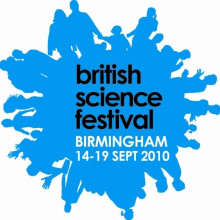
12:32 - British Science Festival Headlines
British Science Festival Headlines
Very exciting news from researchers at Kings college London - Richard Smith announced the development of a technique that extends the lifespan of a transplanted organ by combating the immune attack that donor organs receive immediately after transplantation. Their trick is to "tether" immune system modulating chemicals to the surfaces of the kidney, which then stop the attack in its tracks. They've done a pilot study that has shown it was safe in 16 patients.
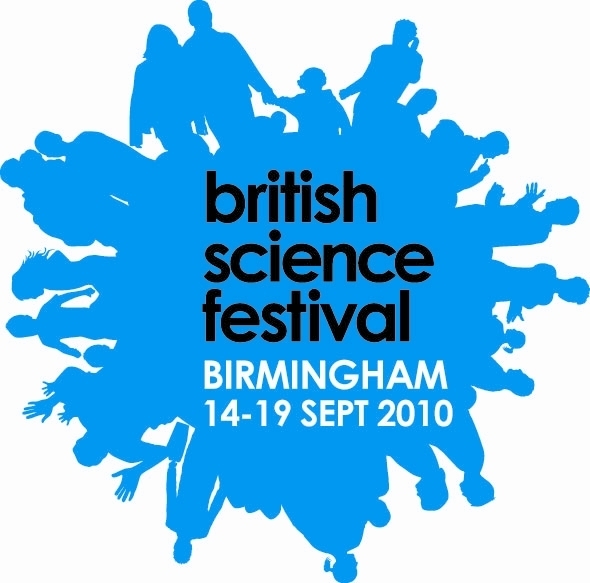 Another announcement from Kings College researchers, this time Dr Manuel Mayr, was of a cheap way to test people for diabetes risk. By looking for micro-RNA markers in the blood, this £2 test is able to identify around half of people with type 2 diabetes before symptoms develop - widening the possible treatment window. As diabetes accounts for about 15% of heart attacks in western Europe, this is an important discovery.
Another announcement from Kings College researchers, this time Dr Manuel Mayr, was of a cheap way to test people for diabetes risk. By looking for micro-RNA markers in the blood, this £2 test is able to identify around half of people with type 2 diabetes before symptoms develop - widening the possible treatment window. As diabetes accounts for about 15% of heart attacks in western Europe, this is an important discovery.
Thelma Lovick, a researcher at the University of Birmingham, announced that small doses of Prozac could block the bodily changes that result in symptoms of pre-menstrual stress, which affects up to 75% of women, in many cases enough to impair daily activities.
We heard that gaining a lover might cost you two friends, the Vatican astronomer dropped by and let slip that he's a science fiction fan and that the Catholic Church will welcome aliens, should we ever find any. There was also an announcement that may seem very common sense - one in 10 people are injured whilst walking and texting!
This amounts to a drop in the ocean of science news published during the science festival. For more, visit the
science festival's news pages.
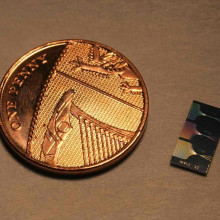
14:27 - Computing with a Quantum Walk
Computing with a Quantum Walk
with Jeremy O’Brien, Director of the Centre for Quantum Photonics and Jonathan Matthews, Bristol University
Ben: - Researchers from Bristol University reported on a development in quantum computing that could bring this revolutionary technology closer, by up to twenty years. I met up with Jonathan Matthews to find out how their device works, but first Jeremy O'Brien, the Director of the Centre for Quantum Photonics, explained why quantum computers are so appealing...
Jeremy: - People have been trying to develop a quantum computer for at least a decade in a serious way, and for a couple of decades people have known that such a device could be incredibly powerful for computation for particular tasks. So there's been a big worldwide effort to realise a quantum computer. Even at this stage it's anticipated to be decades away though, and the reason for that is that you need to be able to control single quantum systems - so that could mean single particles of light, single photons or single electrons, or single atoms. You need to be able to couple them together in complex ways to control them and manipulate them and read out the state that they are in. So it's an incredible quantum engineering challenge, if you like, to be able to make such a device. There's tasks that we know that we can do with a quantum computer exponentially faster than we can do with a conventional computer. So that means we can do problems that are intractable on a conventional computer and they are ones in which the time taken to do the computation grows exponentially with the problem size. For a quantum computer we don't have that - they are linked in a sensible way with one another - the size of the problem and the time taken.
Ben: - So rather than an evolution of the existing computer we are looking at a revolution of the sorts of technology we use?
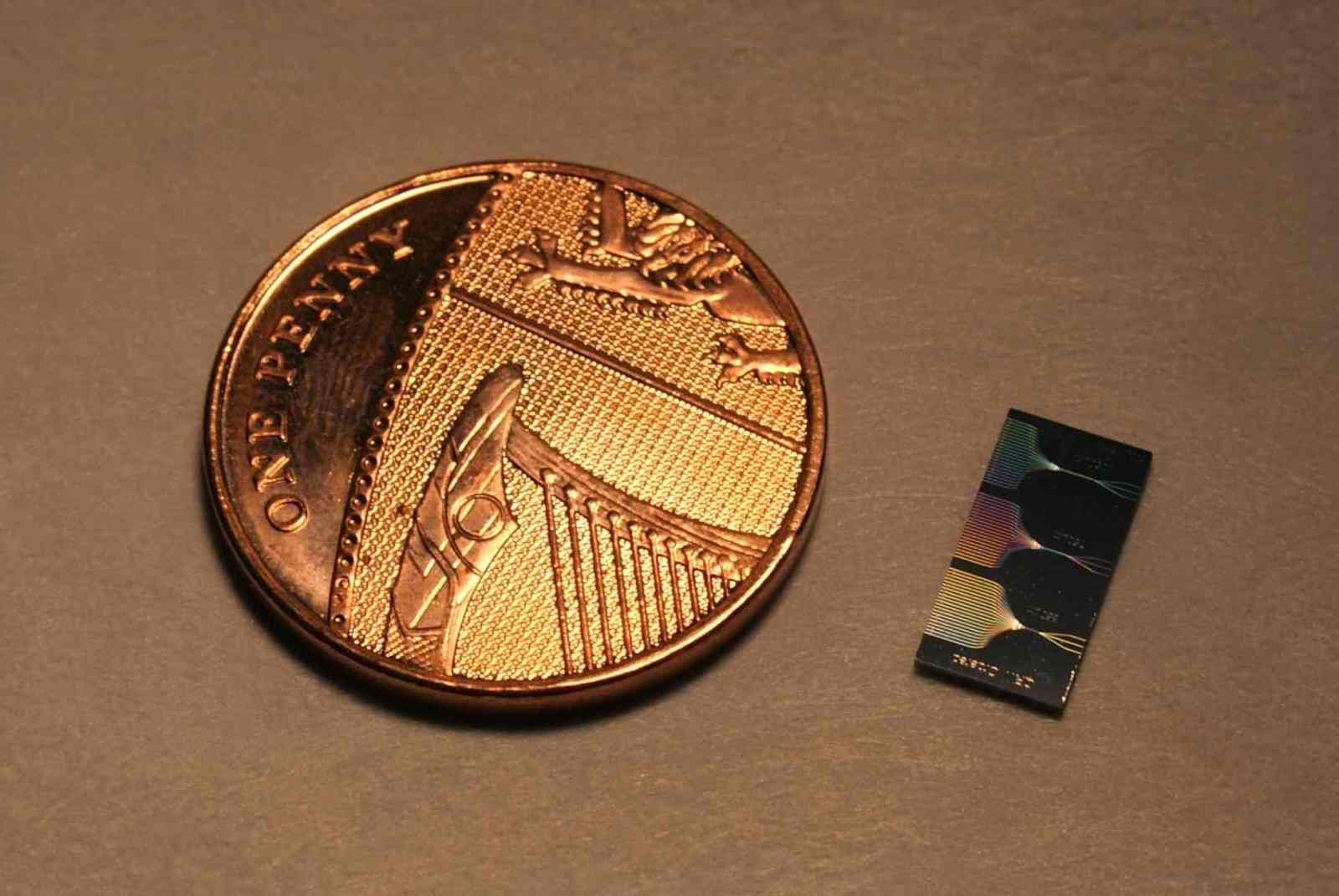 Jeremy: - That's exactly right. So it's a completely different way of doing computation. The idea here is to harness uniquely quantum mechanical effects. So quantum mechanics is the theory that explains how the world works at its most fundamental level - how single photons, single atoms and single molecules, and so on, behave and interact with one another - and it's surprisingly different to the way the world works in our every day experience. For example, it tells us that an object can be in two places or more places indeed, simultaneously, that two objects can be inextricably linked with one another, no matter how far apart they are, such that a measurement on one will instantaneously affect the other one. We call these effects "superposition" and "entanglement" but that's essentially what they are.
Jeremy: - That's exactly right. So it's a completely different way of doing computation. The idea here is to harness uniquely quantum mechanical effects. So quantum mechanics is the theory that explains how the world works at its most fundamental level - how single photons, single atoms and single molecules, and so on, behave and interact with one another - and it's surprisingly different to the way the world works in our every day experience. For example, it tells us that an object can be in two places or more places indeed, simultaneously, that two objects can be inextricably linked with one another, no matter how far apart they are, such that a measurement on one will instantaneously affect the other one. We call these effects "superposition" and "entanglement" but that's essentially what they are.
Ben: - Jonathan, if I could bring you in here, what physically is this device that you've developed?
Jonathan: - This device is an integrated optical chip. It uses what we call "wave guides" to guide light through a monolithic structure - a fixed structure, and these wave guides work very much like optical fibres - like pipes for light if you will. And what we do is we pattern several of these wave guides close together so that the photons can actually tunnel directly between neighbouring wave guides, or neighbouring pipes, and this allows us to see these superposition patterns that we call "quantum walks."
Ben: - What is a quantum walk and how would it differ from a classical walk?
Jonathan: - Perhaps I can start with a classical walk. A classical walk - you can realise by dropping a marble and giving it a series of choices by going left or right as it hits a bunch of pins arranged in a grid pattern, and this will give you a normal distribution at the bottom - a bell curve. So that's based on the marble being given a choice of going left or right, based on probability. But if you give the marble the possibility of going left and right, it has the possibility of interfering with itself, and you get at the end a very different statistical outcome. These statistical outcomes include features such as propagating much faster - the distribution propagates much quicker than in the classical case. It's this kind of behaviour that can be really harnessed in quantum technologies.
Ben: - So, a quantum object will give you a very different likelihood of landing in any particular place from this walk, and that's when you put one photon through. Your work is working on putting more than one through to see how that works out. What's the advantage of doing that?
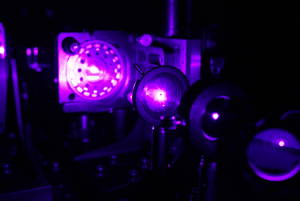 Jonathan: - A key thing is you need the two photons to be exactly the same in every single property, but they quantum interfere with each other, and the fact that there are two photons, gives you a different statistical output than if you put in one photon and then put another photon in, and compare the two results.
Jonathan: - A key thing is you need the two photons to be exactly the same in every single property, but they quantum interfere with each other, and the fact that there are two photons, gives you a different statistical output than if you put in one photon and then put another photon in, and compare the two results.
Ben: - So in terms of quantum computing, why is this an advantage?
Jonathan: - Well this allows us to simulate more complicated structures. So quantum walks move around an environment that mathematicians call graphs, and these environments essentially become exponentially more complicated as you linearly increase the number of photons. So if I have one photon, it's moving through a system of let's say, 20 wave guides, then my system is of size 20, whereas if I stick two photons into the device, then I'm simulating a structure that's of the order of 20 squared.
Ben: - So Jeremy, coming back to you, what do we hope to use these quantum computers for?
Jeremy: - So these particular types of computers based on quantum walks are in principle able to realise an universal quantum computer, so there's an exciting and important theoretical result to show that quantum walks are able to perform any type of quantum computation. But in the nearer term we expect to be able to simulate important quantum systems using these quantum walks in a sort of direct way. The types of things that we might be interested in simulating are complex molecules that might be relevant to designing new pharmaceuticals or new materials. And it turns out that if we have a molecule with in the order of thirty atoms in it, that's the limit of what we can reliably calculate using a conventional computer, even using a super computer today. And the reason is that the description of that system grows exponentially in the same way that Jonathan described the exponential growth of the quantum walk as we add more particles to it. Other applications include understanding natural processes such as photosynthesis which rely on quantum coherent effects for their operation.
Ben: - So by how much do you think your work has bought forward the reality of quantum computing?
Jeremy: - So I think it's fair to say that the majority of people working in the field of quantum information science and quantum computing specifically, believe that an universal quantum computer is decades away. But we're optimistic that using this quantum walk-type technique, we'll be able to make a device that's able to do things that can't be done on a conventional computer within a 5-year timescale.
Ben: - That was Jeremy O'Brien and before him, Jonathan Matthew, explaining how the phenomenon of quantum walk could help to lead to a revolution in computing. Their paper was published this week in the journal Science.
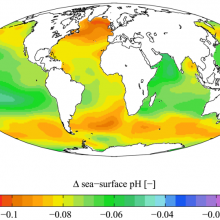
21:50 - Planet Earth Online - Ocean Acidification
Planet Earth Online - Ocean Acidification
with Steve Widdicombe, Plymouth Marine Laboratory
The effects of climate change range from rising temperatures and higher sea levels, to extreme weather and mass extinctions. If that wasn't bad enough, there's a hidden process that's over the underway in the seas and that is that the oceans are becoming more acidic. In the latest of our features from the Planet Earth Podcast Team, Richard Hollingham accept reports from the Plymouth Marine Laboratory where scientists were investigating the effects of ocean acidification...
Richard - Steve Widdicombe's lab at the Plymouth Marine Laboratory is filled with tanks of water, from rows of deep baths in the centre of the room to a series of ten tanks around the size of oil drums along the side.
Steve - In those tanks, we can actually change the chemical parameters of the seawater to mimic what the oceans might be like in 100 to 150 years times. And we do that by adding carbon dioxide. What we're trying to do is explore the effects of increased CO2 on marine eco-systems.
Richard - Kate Delahowe for instance is studying the effects of ocean acidification on the behaviour of hermit crabs. The crabs is working on or live in periwinkle shells, and right now, it's time for their lunch. 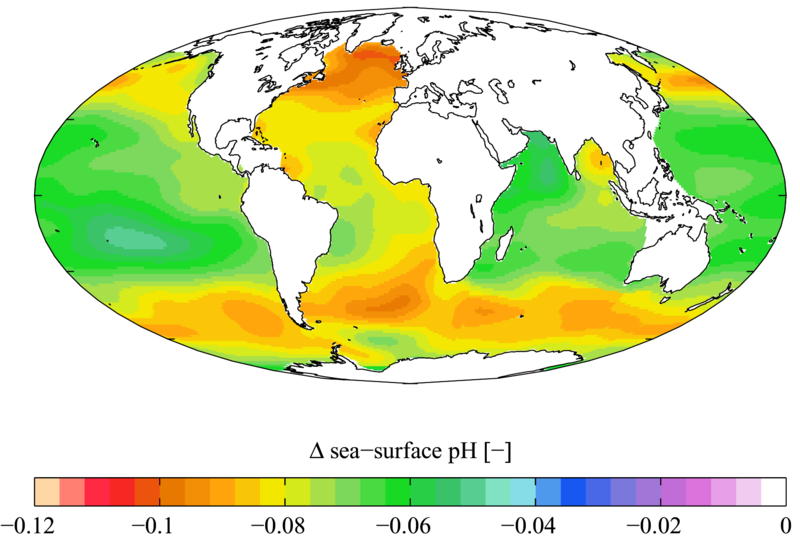
Kate - Well with these hermit crabs, I'm looking at how the ability to pick up the odours of foods is affected. So, what I'll do is I'll keep them in certain treatments, but then periodically, I'll take them out of the treatments, and put them into an observational chamber and then I'll put in food cues and see whether they can pick them up on the water or not. Also, they have two pairs of antennae and they have these shorter antennules which they flick through the water very rapidly. It's like their sniffing response and it helps them to pick up odours in the water, and it's quite easy to record that, so that's also what I'm recording as well.
Richard - We've come out of the laboratory to a little bay just east of the main city of Plymouth and with Nadia Kristen who's got pan scourers in her hand. Why?
Nadia - I'm looking at the effects of ocean acidification on rocky shore communities and what I do with these pan scourers is basically, these are community collectors. They mimic kelp holdfast, so loads of different invertebrate species will start to colonise these pan scourers so that's how we can actually collect the rocky shore communities I will need for my experiment.
Richard - So you'll put these on the rocks, they will mimic the base of the kelp and you will collect effectively a community of organisms.
Nadia - There are lots of studies, just looking at one species and the response is quite a lot between different species, so it's really difficult to predict how communities or even an ecosystem will respond to ocean acidification, and that's why in my study, I'm looking at the whole community itself. So, I want to look how the community as a whole responds to ocean acidification.
 Richard - And back in his lab, I asked Steve Widdicombe whether he'd been surprised by what they'd found so far.
Richard - And back in his lab, I asked Steve Widdicombe whether he'd been surprised by what they'd found so far.
Steve - Often, we are not getting the results we expect and that the more we look into the issue of the effects of high levels CO2 on marine organisms, the more we are astounded by the complexity of the responses that occur, and the trade-offs that occur between different responses. For example, we've had an instance where a marine organism is seen to be unaffected by the exposure to high CO2, but as we looked more closely, we've seen the fact that some of its muscles have wasted away because it's been using energy to respond to that. So whilst on the surface, things look fine, underneath, that's not always the case.
Richard - How important is it to get this sort of information?
Steve - Well the information we're providing here, we think is essential because yes, ocean acidification is happening, and part of the effects we're seeing here will enable people to see the consequences of producing more CO2. But also, it allows managers the opportunity to see how the oceans might be in 50 to 100 year's time. And whilst they may not be in a position to stop it, they are in a position to develop management strategies and mitigation strategies to be able to live with this change.

Can water be compressed into a solid?
Ben - We've had an email question from Jim Irvin and he wants to know if you can compress water into a solid. Now obviously you can turn water into a solid just by taking heat away, but can you just press it hard enough to make into a solid structure? Dave what do you think?
Dave - The simple answer is, yes you can. You'd need a ridiculous amount of force, but it is possible. When this happens a different form of ice is formed, called ice IV, which is a different crystal structure to conventional ice.
Ben - Conventional ice has a greater volume than liquid water; so compressing water in order to turn it into conventional ice, you'd need to somehow compress it into a solid and allow it to expand?
Dave - Yes, so it just wouldn't work if you tried to produce conventionally-structured ice.
Ben - Wouldn't work?
Dave - No; but if the ice forms in a different crystal structure that doesn't have a larger volume, which you can achieve with a pressure of about 2 Gigapascals - or about 20,000 atmospheres, which is the same pressure you get under 20 kilometres of ice or water - then you can produce ice at normal room temperature.
Ben - Are there any bits of the world where water is under that sort of pressure, 20 kilometres down deep in some of the deep ocean ridges? And if so why doesn't it form the ice structure?
Dave - Twenty kilometres is about twice as deep as the deepest parts of the ocean, so probably not; though there is no reason why, on other planets with a deeper ocean, you couldn't get this effect.
Ben - So water seems like such a simple thing, such a simple everyday thing, but actually it's fascinating stuff, isn't it?
Dave - It's absolutely bizarre stuff!
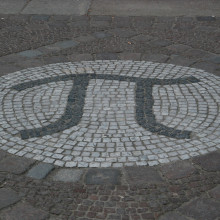
36:30 - Pi Time
Pi Time
with Robin Wilson, Professor of Pure Mathematics at the Open University
Ben - This last week has been the British Science Festival based in the city of Birmingham. The events there covered the full range of sciences, technology, engineering, and maths, and one event even celebrated Pi time, that was 3:14 pm on the 15th of the 9th month - 3.14 15/9. It's the closest you can get - I'm sorry in America that one's just not going to work (as it would be 3.14 9/15). So Julia Graham met Robin Wilson - he's Emeritus Professor of Pure Mathematics at the Open University, to find out a bit more about Pi.
 Robin -
Robin -
It is a favourite project of mineA new value of Pi to assignI would fix it at 3For it's simpler, you seeThan 3.14159
That number, 3.14159, of course is not the exact value of Pi. The exact value of Pi - no one knows - it's a number you go on writing forever and ever. So what is Pi? We all learned about Pi at school. It's to do with measuring circles. First of all, it is the ratio of the circumference of a circle to its diameter. We all know the formula of circumference is 2πr where r is the radius which is the same as Pi x diameter. But we also know that Pi comes up in the area of a circle, πr2. But trying to find the value of Pi to more and more degrees of accuracy is something that mathematicians have been trying to do for 4,000 years. So the earliest were the Egyptians and the Egyptians had a value which was actually 256 / 81. Now that's about 3.16 - which is just a little bit too large.
Julia - Do you know how they arrived at that number?
Robin - Yes. They regarded the area of a circle as approximately the same as an area of an octagon. They found that what they should do to work out the area of the circle, they take 8/9 of the diameter and square it, then that gives you the area of the circle, and that corresponds to about 3.16. It's a little too large, but not much.
But the real breakthrough came with the Greeks. We all know that the ancient Greeks really launched mathematics. Archimedes, who of course is well-known for many, many things - he was interested in finding the value of Pi. And the way he did it was, he drew a circle and he drew a hexagon. He put it inside the circle then he did another hexagon outside, and then he measured the perimeter of the hexagons. So the one inside gave him a value of 3 and the one outside gave a value about 3.4, so that tells you the Pi and circumference of the circle lies between those. Well that's not very accurate, so he then replaced the hexagon by dodecagon. In other words, he multiplied the number of sides from 6 to 12 and that gave him a better upper estimate, and a better lower estimate. Still not very good, so he went up to 24, 48, 96, and he stopped at 96. And his calculation showed that Pi was a little bit less than 22/7 and a little bit more than 3 and 10 71st, but basically that gave Pi to two decimal places, 3.14.
And then for the next 2,000 years, people used the same method - exactly the same method. In 1596 a German mathematician living in the Netherlands called Ludolph van Ceulen went up to 2 to the power of 62 sides, basically millions and millions of sides, and he found Pi to 35 decimal places, and he was so thrilled at this that he instructed that those Pi to 35 decimal places should be inscribed on his tomb stone.
Julia - What is it that still fascinates mathematicians today about Pi?
Robin - If you give me any pattern of numbers like 6, 4, 8, 2, 3, 5, 9 for example - I just made that up now - we believe that any pattern of numbers like that, that you'll find it somewhere in the digits of Pi. We don't know that. That has never been proved and this is why people try now to find Pi to more and more decimal places. I mean, if you want to study practical problems, you probably don't need to go for more than about 5 or 6 decimal places, but on the other hand, if you want to find out what Pi is all about, is it true that every pattern of numbers that you give me appears somewhere in that list? So that's one of the fascinating things that people don't know the answer to.
Julia - How many decimal places do we know Pi to now?
Robin - In 2002, a Japanese mathematician called Kanada reached a trillion, and then just last month, August 2010, we've reached 5 trillion. No practical use whatsoever, but why do you do it? Because it's there, just like climbing mountains.
Ben - Professor Robin Wilson there, explaining why understanding Pi is a bit like climbing a mountain. Unfortunately, that gave me images of mountains of pie, so I'm now very much looking forward to my dinner. He was talking to Julia Graham.
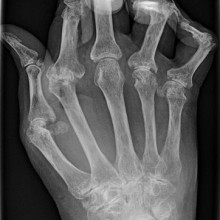
41:39 - Rheumatoid Arthritis
Rheumatoid Arthritis
with Karim Raza, Senior Lecturer at Birmingham University, Consultant Rheumatologist at Sandwell & West Birmingham Hospitals
There are many different types of arthritis and it can be caused by infection, trauma, autoimmune diseases, or just simple wear and tear with age. One of the more common forms is rheumatoid arthritis, but if you diagnose it early enough, it can be controlled well with drugs. Sadly rheumatologists often don't see these cases until a long time after the onset of symptoms. Speaking with Ben Valsler, Karim Raza, Senior Lecturer at Birmingham University, Consultant Rheumatologist at Sandwell and West Birmingham Hospitals explains...
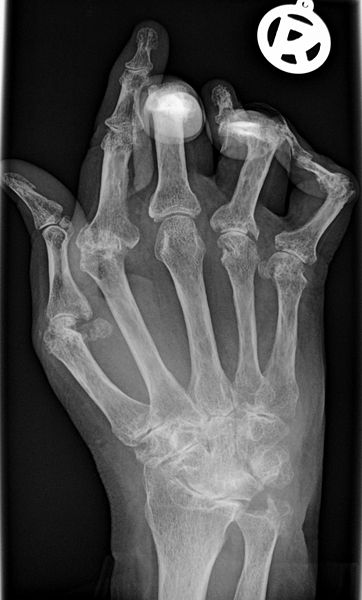 Karim - So rheumatoid arthritis is a common arthritis. It affects 1% of the population and is characterised by inflammation of the synovium. The synovium is a very thin layer of cells which lines most joints and it produces the synovial fluid, the lubricating fluid within the joint. In people with rheumatoid arthritis that synovium becomes inflamed and it becomes thickened. As a result of that people get pain, stiffness in the joints, and most importantly, that synovium actually eats into and destroys bone. So in the long term it causes damage and destruction to the joints which is irreversible actually once the destruction has happened, which is why it's important to catch people early before the damage sets in.
Karim - So rheumatoid arthritis is a common arthritis. It affects 1% of the population and is characterised by inflammation of the synovium. The synovium is a very thin layer of cells which lines most joints and it produces the synovial fluid, the lubricating fluid within the joint. In people with rheumatoid arthritis that synovium becomes inflamed and it becomes thickened. As a result of that people get pain, stiffness in the joints, and most importantly, that synovium actually eats into and destroys bone. So in the long term it causes damage and destruction to the joints which is irreversible actually once the destruction has happened, which is why it's important to catch people early before the damage sets in.
Ben - How does it affect quality of life? Obviously living with pain is not pleasant, but a lot of the time people find ways to cope. How does rheumatoid arthritis affect people's ability to work for example?
Karim - It has a huge impact on function. So within 5 years of a diagnosis of rheumatoid arthritis about 25% of people will have lost the jobs that they were in, and a proportion will clearly also be functioning less, and much less effectively in the jobs that they're in. So it does have a very big impact on function and quality of life.
Ben - What are our treatment options at the moment?
Karim - Treatment options that we have when we first see patients with rheumatoid arthritis are with drugs which modulate the immune system. So we want to dampen down the inflammation in the lining of the joint, and the most commonly used drug at our disposal is a drug called methotrexate. If you don't respond to methotrexate, we add in other oral drugs, and if you don't respond to those, which takes you down to about 10% to 20% of the rheumatoid population, then we have to move on to stronger drugs, which have been designed to specifically target particular components of the immune system.
Ben - Is it important to catch it as early as possible?
Karim - All the data that we have available suggests that the first 3 or 4 months after the onset of symptoms is a really critical time, and that if you can intervene at that stage you can really slow down the rate of progression of disease.
Ben - So what are the factors that are limiting early treatment at the moment?
Karim - One of the key factors that's limiting early treatment is the fact that we don't get to see our patients in our rheumatology clinics as early as we'd like. And if you think about what the determinants for delay are - say you develop inflammation in your joints - you'll spend a little bit of time deciding what to do about it and whether to go and see a General Practitioner. Then your GP will spend a bit of time deciding whether to refer you to the hospital, and then you'll get stuck on a hospital waiting list somewhere. So there are three levels of delay, and actually, when people have looked around UK at those three levels of delay, the main reason for delay in fact is delay on the part of the patient.
So if I told you that the average delay for a patient with rheumatoid was 6 months from when their symptoms began to when they saw a rheumatologist, if you break that down into this three components, three months tends to be delay on the part of the patient and the other 3 months is split between the delay on the part of the GP and the hospital. So the patient is accounting for the largest bit of it. And patients delay because they don't know anything about rheumatoid arthritis. They have no idea that it's a serious disease. They have no idea that there's treatment available for it. They have no idea that early treatment is important. In fact, when we've asked our patients, the vast majority have never even heard of rheumatoid arthritis.
Ben - So what should people look out for? How can they tell the difference between an ache or pain, or perhaps a bit of swelling because of minor trauma, and something that they do need to go and speak to their GP about?
Karim - So there are a number of key features in the story that we look for when we take a patient's history, and these are the kind of things that patients should be looking for. The first of them is morning stiffness. Often our patient is stiff for at least an hour in the mornings. They start easing up as they start using their joints, as they start doing things, but they're very, very stiff in the mornings. I'm not talking about the 2 or 3 minutes of morning stiffness which you probably all feel. When we're all out of bed, it takes us a few minutes to get going - I mean this is morning stiffness that lasts for at least an hour. The second thing is what joints are affected. So rheumatoid arthritis typically begins with the knuckles and the small joints of the fingers, the wrists, and the small joints of the toes. So patients may well notice pain, swelling, and stiffness in the hands, and in the feet. So it's the morning stiffness and the pattern in distribution of joint problems which are key features of new onset of rheumatoid arthritis. Anyone who has those should really be going to see their GP.
Dave - That was Karim Raza on the symptoms that suggest rheumatoid arthritis and how the biggest problem with catching it early, is actually the patients themselves.
Ben - And this is definitely worth thinking about because something else that Karim said to me off-mic was that having rheumatoid arthritis actually increases your risk of heart attack because chronic inflammation tends to lead to systemic problems. So if you do think you have those symptoms, if you do get stiffness for an hour in the morning, it's well worth going to see your GP.

47:08 - The Cultural Aspects of Sleep
The Cultural Aspects of Sleep
with Helen Ball, Durham University
What constitutes a good night sleep? Here in the UK, we're told that it's a solid 8 hours overnight, tucked up in bed in the dark and in the quiet. But if we don't do that or if we can't do that, we're thought of as being unusual or we're told that we have a sleep problem. Helen Ball, Professor of Anthropology at Durham University is looking into the cultural aspects of sleep...
Helen - We're interested in the mismatch that happens between our evolved physiology of sleep and the way in which we sleep in modern Western societies. So we're looking at things that we think of as sleep problems in our society but that when you look at sleep habits across the world, they're actually normal human sleep patterns.
Ben - We are fairly well conditioned to think that we need to go to bed at a reasonable time, get 8 hours solid sleep in one block, and this obviously fits around work or school, or our lifestyle. Is that backed up by good science? Is that physiologically a healthy way to sleep?
 Helen - Well that's how sleep has been studied in sleep laboratories because that's the model of what good sleep is in the Western world but if you look at historical reports, there's an interesting book by a guy called Roger Ekirch called "At Day's Close" and he looked at a lot of diaries from between 5 and 200 years ago and he found people talking about how they would have a first and second sleep. So you would go to bed at twilight, you would spend a couple of hours relaxing and winding down. You'd sleep for 4 or 5 hours then you'd wake up and you'd have what was called a "watching period" where you're quiet awake for a couple of hours, and then you'll go back to sleep for another 2 or 3 hours.
Helen - Well that's how sleep has been studied in sleep laboratories because that's the model of what good sleep is in the Western world but if you look at historical reports, there's an interesting book by a guy called Roger Ekirch called "At Day's Close" and he looked at a lot of diaries from between 5 and 200 years ago and he found people talking about how they would have a first and second sleep. So you would go to bed at twilight, you would spend a couple of hours relaxing and winding down. You'd sleep for 4 or 5 hours then you'd wake up and you'd have what was called a "watching period" where you're quiet awake for a couple of hours, and then you'll go back to sleep for another 2 or 3 hours.
It puts me in mind that some of the problems that people think that that we have with insomnia and the insomnia epidemic that we supposedly have in the Western world is actually an artificial creation of trying to force ourselves to sleep for a solid block when actually, physiologically, that's not what our bodies expect us to do.
Another issue is trouble falling asleep in the evening, and there's a lot of sleep hygiene advice out there about what you should do if you're having trouble falling asleep. Some of it makes a lot of physiological sense like staying away from things that act as artificial stimulants like computer screens and TV screens, and obviously, caffeine and stimulant drinks and all the rest of it. There are other things about sleep hygiene that are really just culturally conditioned, but if you think about how people would have slept throughout history and do sleep around the world, they don't sleep in soft, comfortable beds, and they don't sleep alone in silent conditions, et cetera. And so, we've entrained ourselves to expect this very rigid and constrained sleep environment.
In some respects, we're setting ourselves up to have these sleep problems and one of the things that I've studied the most is the sleep of infants and the way in which we expect infants to sleep. Parents start out by trying to teach their infants to sleep for long periods of time in dark, quiet rooms, and they tiptoe around them so they don't wake them up, but babies all around the world sleep in hugely social, noisy environments, being carried around, et cetera, so babies can do that. There's no reason our babies can't do that. We don't have to teach them that the only way to sleep is in a silent room with the lights out, with a very comfortable warm bed.
Ben - It's also true that the amount that we sleep, the amount we need to sleep and the times that we need to sleep change quite dramatically through our life.
Helen - Yeah, this is another good point. Historically, over the last 50 or 60 years, we've tried to get children to do what we call "settling" which is starting to consolidate their sleep into night time chunks earlier and earlier, and earlier. 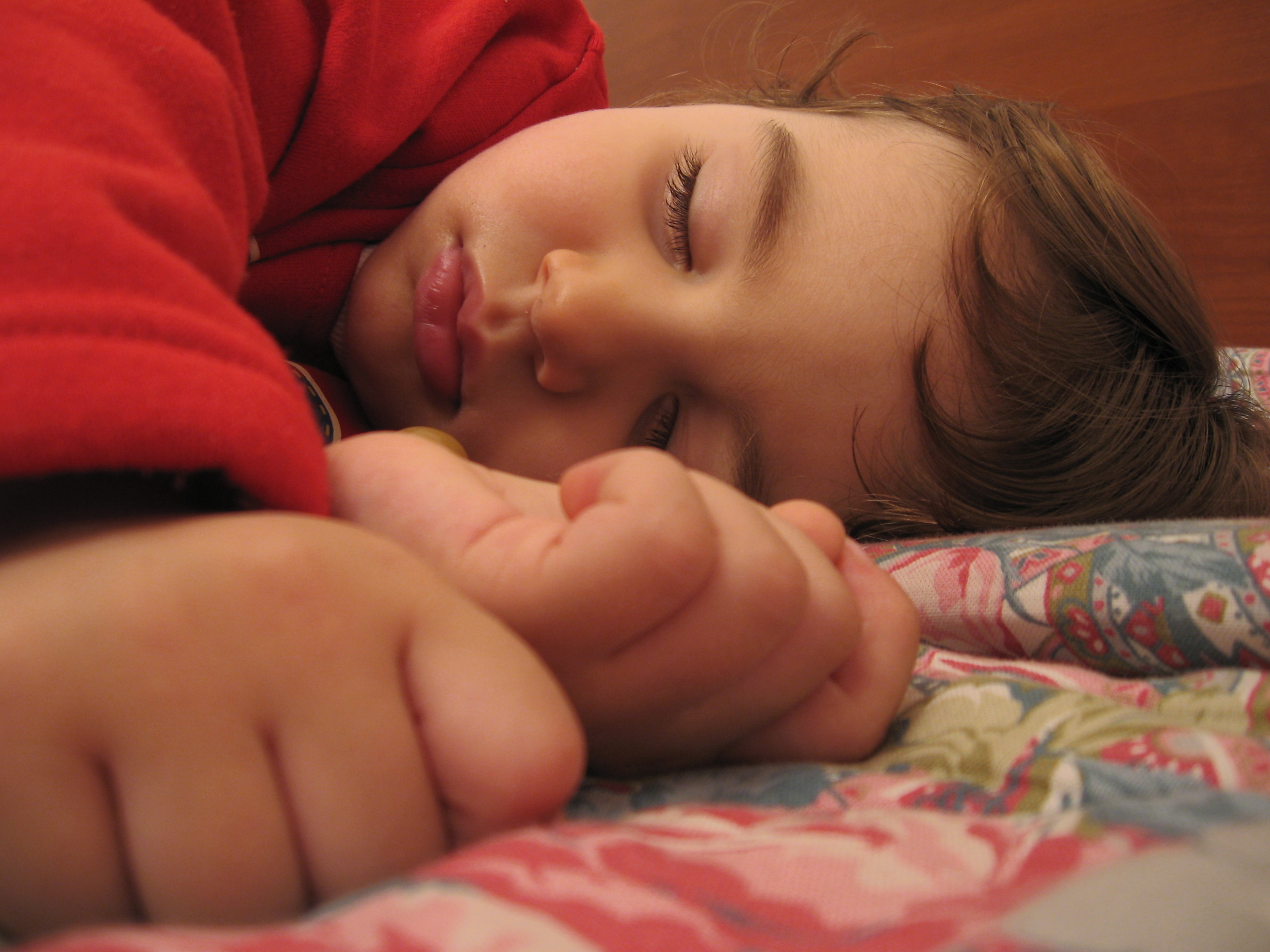 People now are trying to sleep train 3-month old babies and 3-month old babies physiologically aren't ready to have their circadian rhythms entrained in that way.
People now are trying to sleep train 3-month old babies and 3-month old babies physiologically aren't ready to have their circadian rhythms entrained in that way.
Children do need a much greater amount of sleep than adults do but if you do a survey of how much children sleep, it ranges anywhere from 9 hours to 15 hours. So, there are biological differences in people in terms of how much sleep they need, but then there are also differences in the ways in which the amount of sleep your body needs can be obtained in a 24-hour period. One of the things that we found in interviews with parents is that they're very resistant to the idea of children having naps during the day in UK culture because [they worry that] if children have naps during the day, they'll stay awake at night. But if we look again at other societies and even the US, there's a very familiar culture there in kindergarten of children having naps in the middle of the afternoon.
Ben - And just lastly, do you think we should try and change our society to fit our sleep needs? Should we have no early morning lessons for teenagers and the ability to have flexi-time at work in order to suit our own sleep patterns?
Helen - Well, the idea of later starts in the morning for teenagers, it's a very popular one. It's been done in some schools in the States and it does seem to have made a difference to academic performance. There is some evidence that teenagers' sleep patterns do undergo a shift, so that they do biologically go to sleep later and wake later so it makes sense to do that. But yes, I think the idea of people being able to incorporate their work lives around their sleep needs is a very good one so more flexi-time would be an excellent idea.
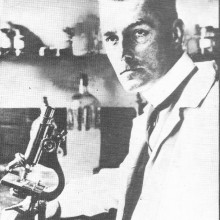
52:50 - Sir Bernard Spilsbury - Science Poetry
Sir Bernard Spilsbury - Science Poetry
with Heather Wastie, Poet
Heather - My name is Heather Wastie and my poem is about one of the first people to work as a forensic pathologist. His name was Sir Bernard Spilsbury.
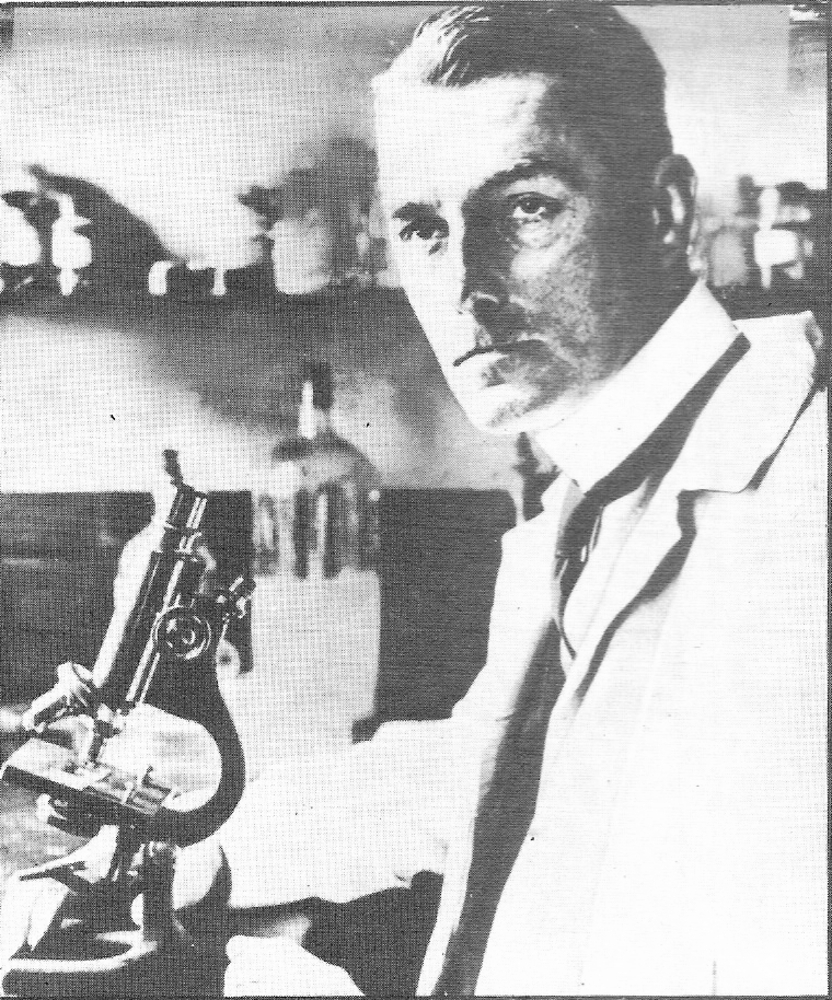
"Hawley Harvey Crippen said his wife called Belle was missing.
Said she'd gone off with her lover to some place or another
And the body beneath his cellar, well, he said it wasn't Belle.
A lie, so it was proved when Bernard Spilsbury entered the case
With his little black book, index cards, and the acrid smell of formaldehyde.
Immersed in his work with very few friends, unemotional, clear in mind,
A quiet, solitary, dignified man; polite, reserved, he worked alone,
And came alive in the cutting room.
With the woman who died of a dry shampoo,
Or little Louisa poisoned by Rhubarb,
The man who had told his poor grieving mother
That something was wrong with his private parts,
Or Aida, a laundress with four young children
Who swallowed quinine dissolved in port wine at a quarter past nine.
Failed abortion, suicide, poisoning with arsenic, matricide,
Doping to render unfit for war, sadomasochists, blood and gore,
Hara-kiri by Japanese and other gruesome jobs like these."

Why is my fridge door harder to open again straight after opening?
Dave - It's a lovely piece of physics, this one. Basically, the magnetic door seal clips on and it makes a really good airtight seal. That means that the fridge is full of fairly warm air from outside then over the next 2 or 3 seconds, that cools down. When air cools down, it shrinks, so it reduces the pressure inside the fridge. So to open that door now, you've got to pull against all that pressure difference and it's really difficult. But if you leave it for a couple of minutes, there are few leaks in there, so the air slowly works its way back in and the pressure is equalised, so it's nice and easy to open again.
55:03 - What do you think of Human Animal Hybrids?
What do you think of Human Animal Hybrids?
with Robin Lovell-Badge, MRC's National Institute for Medical Research
Robin Lovell-Badge is from the National Institute for Medical Research and he's been researching public opinion of animal experiments that have a key biological human element as he explained to Smitha Mundasad...
Robin LB - It began really because of the debates around the Human Fertilisation and Embryo Act where we were talking about issues of combining human and animal material in the context of human embryos, so making hybrids - inter-species hybrids - and things like that. It became apparent that certainly members of parliament and some members of the public who asked questions about this didn't realise the extent to which research is already going on, doing it the other way around - having animals where we're introducing human material.
That can be to put human genes into animals to make so-called transgenic animals, transgenic mice for example, and there are many thousands of examples where we now have made mice carrying a human gene, now, all the way out to a whole human chromosome: the Down's mouse is a model of human Down's syndrome where a human chromosome 21 has been added to a mouse genome. 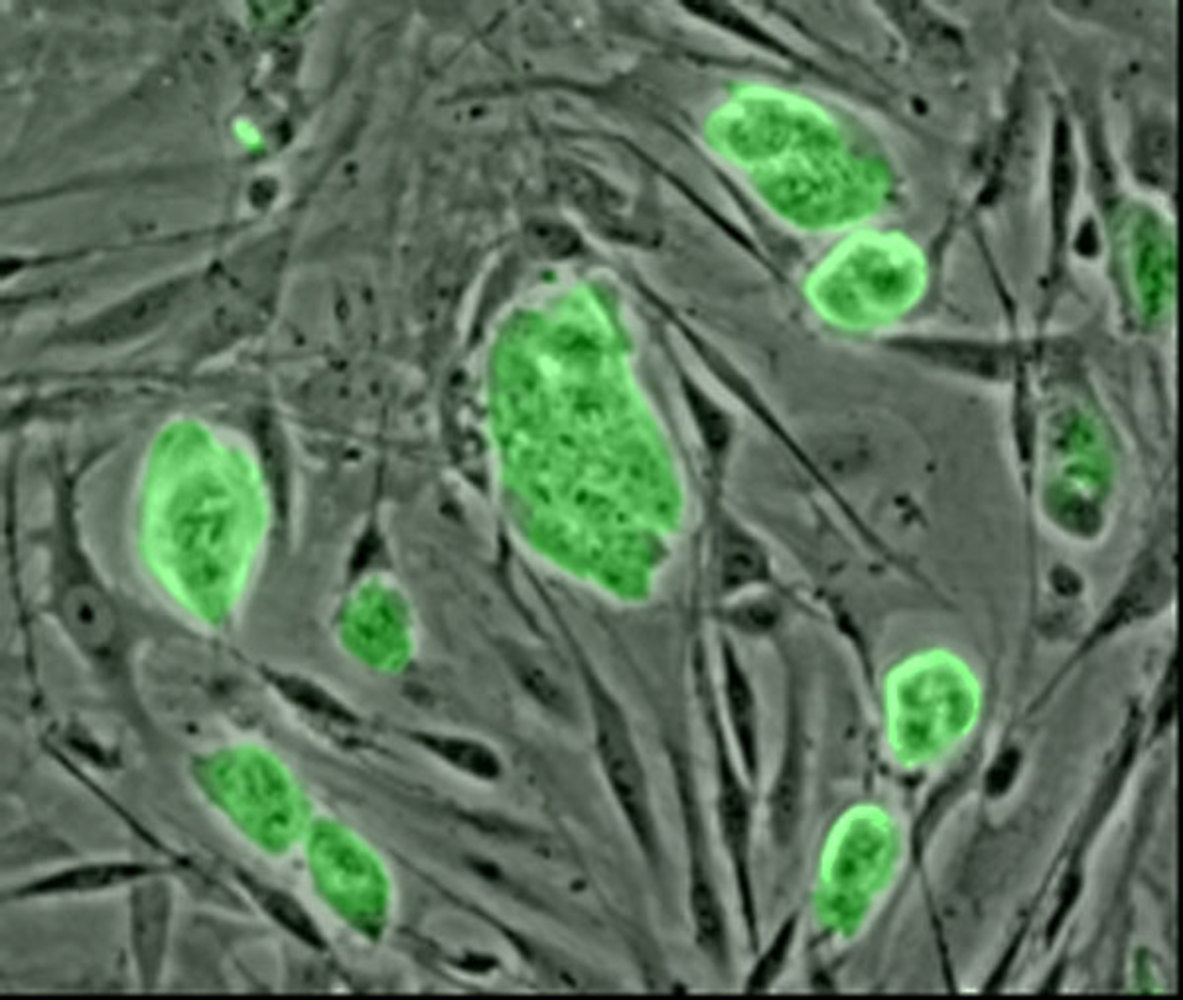
And then the other type of manipulation is where you put human cells into an animal to make a chimera. There are different ways you can make a chimera: it can be done from early embryonic stages all the way up to adult animals where you introduce human stem cells from the nervous system into stroke-damaged rat brains, for example.
And so, all this type of research is going on quite happily and everyone seems to be very happy with it. The question is, should there be limits? What are the issues when you start putting, for example, a whole human chromosome into mice? Would that be something that we should be worried about scientifically and ethically?
Smitha - What have you done so far to look into where to set the limits or what the public thinks about it?
Robin LB - The working group has basically been taking evidence from a wide range of people who may have an interest and then we've also had a public engagement exercise. In general, the small sample of public seemed on the whole really very accepting, but they were pragmatic. So, if it had some obvious medical benefit, not necessarily immediately but it was going to lead to something, they had no problems really - almost whatever our scientists did.
Smitha - Were there any particular types of research or experiments that the public were not so happy with?
Robin LB - They didn't seem to have any limits. The areas of research that they have most concern about were those involving particular organ structures, for example the brain and the reproductive system. The brain in particular, changing behaviour of an animal in a way that it would no longer be the original animal or - it's very unlikely this would ever happen - that it started acquiring human characteristics. And then reproductive tissue, so whether you have animals that were able to produce human eggs or sperm - people are a little concerned about that. Although, when told what the reasons why people were doing this, they could accept it. So providing some context for the research makes people much happier to accept it. Essentially what that means is it puts the emphasis on the scientists who are doing this type of research to justify their experiments.

59:01 - Is olive oil-based butter better for your health?
Is olive oil-based butter better for your health?
We put this question to Bryan Lockwood, I'm a Professor of Pharmaceutical Science at the University of Manchester: Bryan - Olive oil has obviously got a long historic use in food and the olives have been eaten for a long time. By now of course, there's plenty of other dietary oils which we use as well. The recent increases in interest in health in westernised countries particularly those in the northern hemisphere has stimulated a vast amount of interest in research into the fat content of our diets. Linked to this, there's an increasing volume of epidemiological evidence which suggests that dairy and animal fats are less healthy, and this is now pretty widely understood in the medical fraternity and also, in the general public at large.
The main reasons why olive oil is supposedly beneficial for you is that the main lipid is oleic acid or oleic acid triglyceride, and it's about 3 quarters of that, and this is a particular type of fatty acid which is unsaturated. In fact, it's a mono unsaturated fatty acid which is accepted as being good for health. There's also some poly unsaturated fatty acids which of course have been widely discussed in the lay literature as well, again, highly beneficial for your health.
Both olive oils and seed oils in general have been showen to reduce low density lipoprotein lipid cholesterol which is abbreviated to LDL-C. This is commonly referred to as the bad type of cholesterol. Total cholesterol is also reduced. The combination of these two activities generally reduces a possibility of cholesterol depositing in the arteries.
Diana - So, olive oil is lower in saturated fat and the more olive oil there is in butter or margarine, the less dairy fat will be present, and therefore, less saturated fat. Our expert added that olive oil also contains high levels of anti-oxidants, and that these prevent free radicals from running around inside your body, damaging cells. But there's no conclusive evidence that anti-oxidants when taken via food actually make that much of a difference. But some people say, olive oil is less healthy when you fry it. Why might this be?
Bryan - Olive oil is quite interesting due to the high level of polyphenolics. You can actually see in the case of virgin oils and extra virgin oils, it's a green to dark green colour. This is judged to be of quality by the food sales people. If you happen to heat olive oil in a frying pan or a pan and get it up to about 93 degrees centigrade, it smokes, and this is obviously degradation of the oil. So, it's not beneficial to burn the olive oil itself, and in fact, this destroys its properties later on, so its anti-oxidant activity is dramatically decreased.
Diana - So there you are. Olive oil smokes slightly earlier than other oils, but if the clinical trials are anything to go by, it may be that losing a few anti-oxidants isn't a great loss.
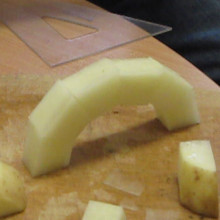









Comments
Add a comment